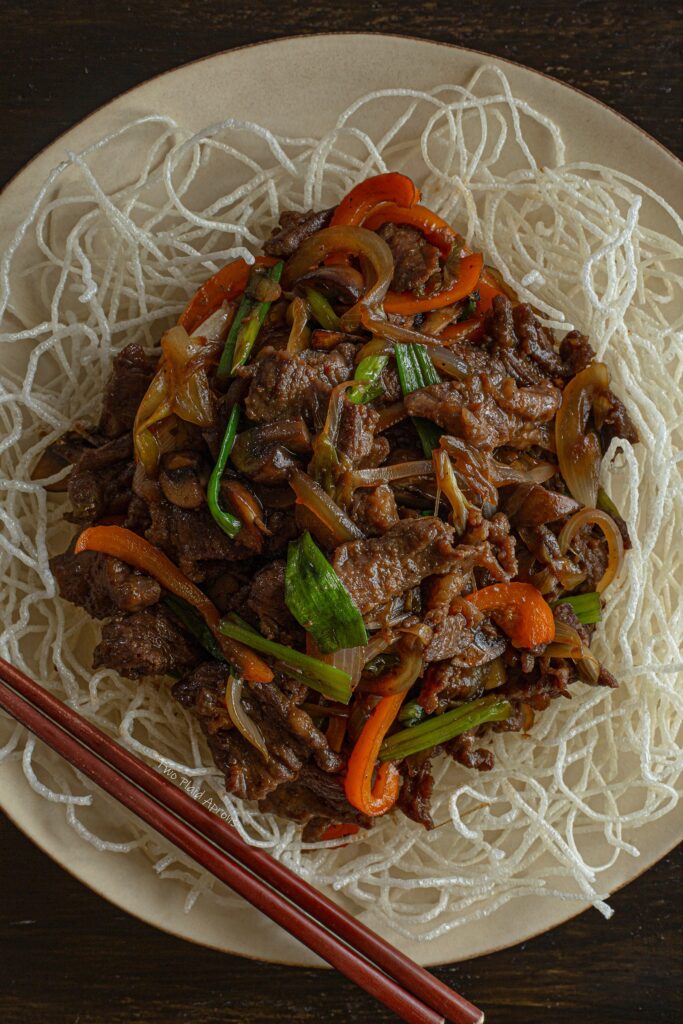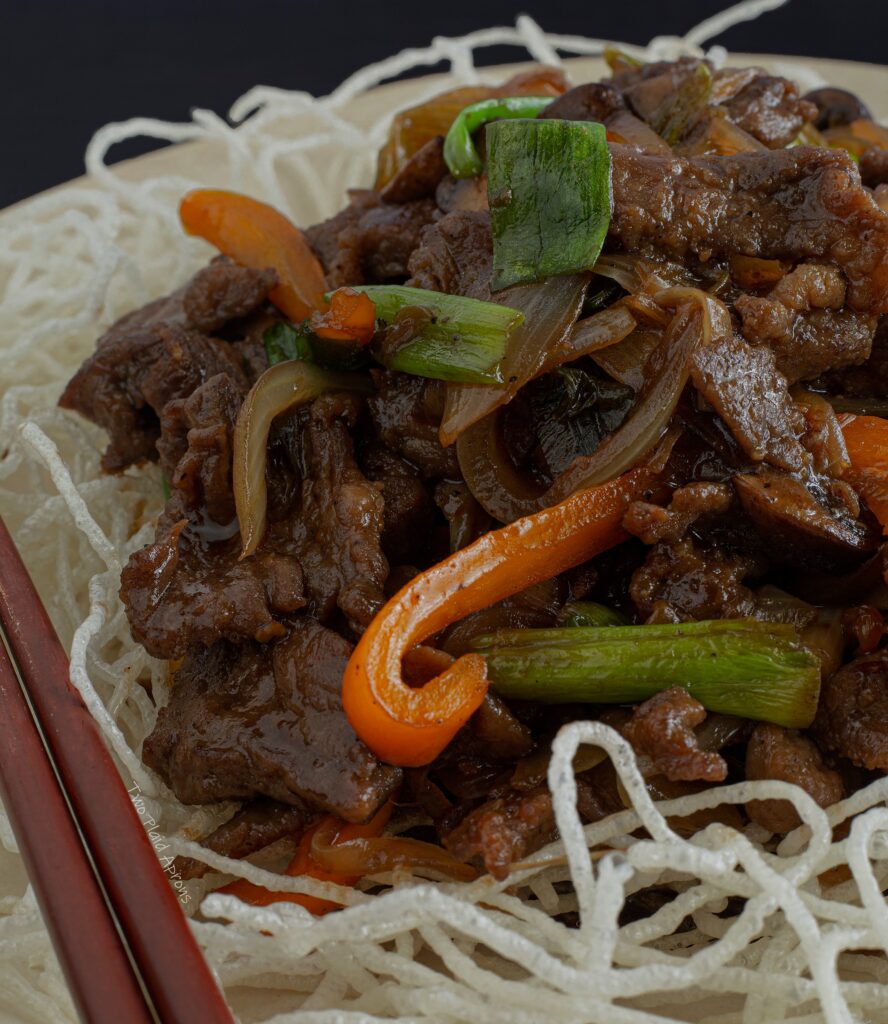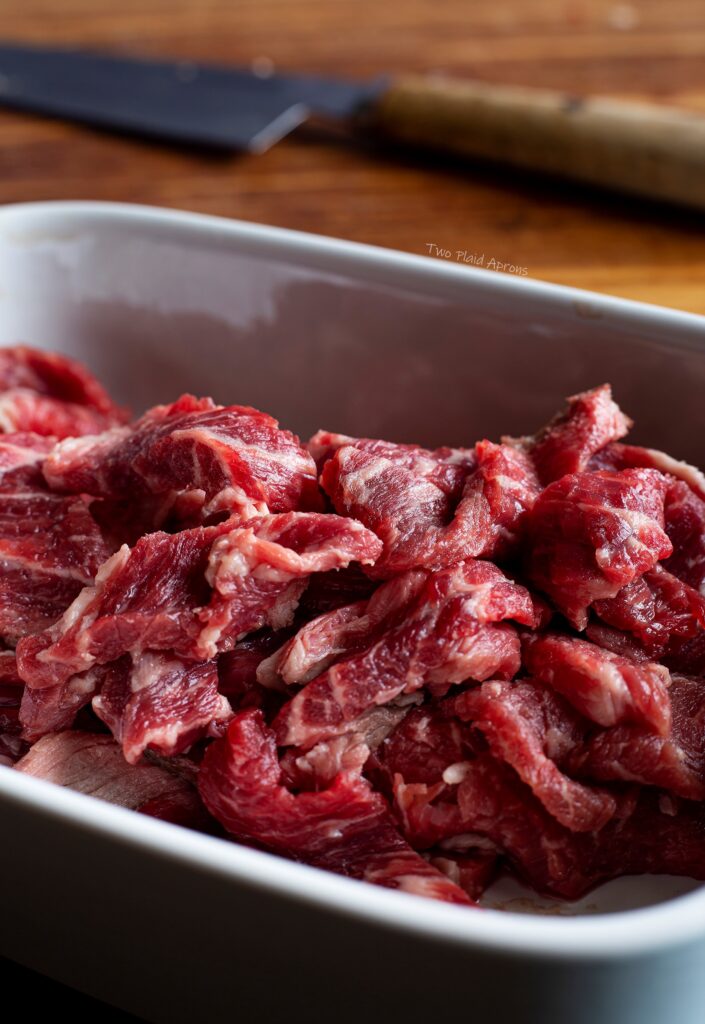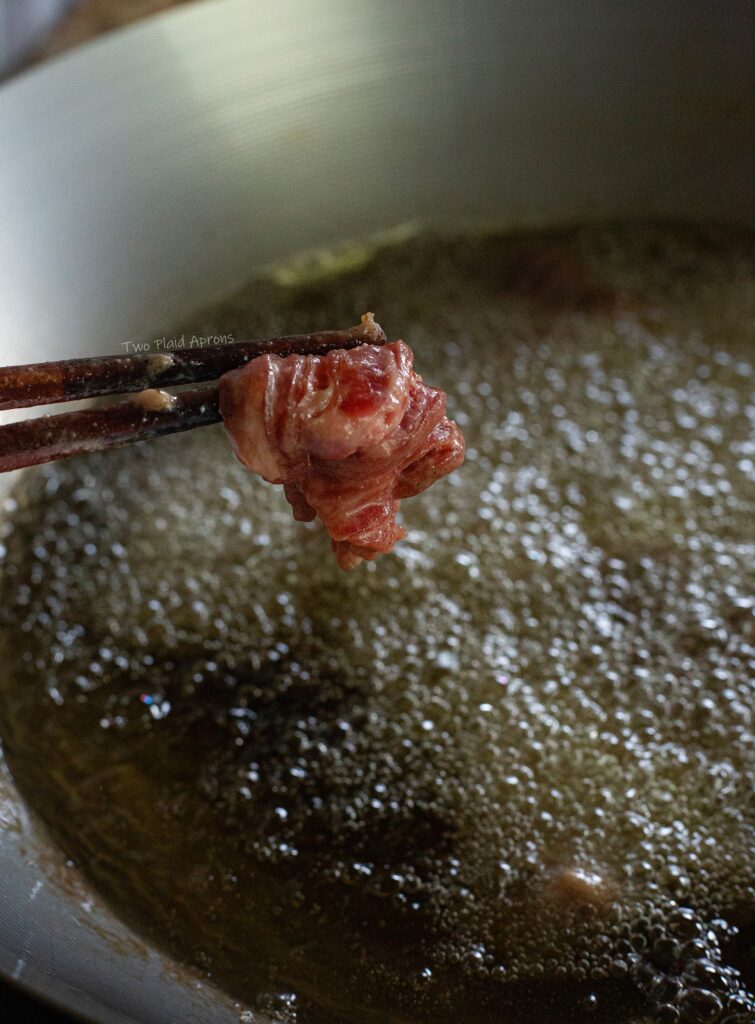Why Do Chinese Restaurants Sell Mongolian Beef
Jump to Recipe Print Recipe

Missing your favorite Chinese restaurant's Mongolian Beef? This Restaurant Style Mongolian Beef is basically a copycat of my parents' Mongolian Beef! It's savory, a little sweet, and has char flavors like it was cooked in a wok. Serve it with a nest of fried vermicelli or steamed white rice, and you'll be on cloud nine!

We know many of you love and probably miss Chinese takeouts as much or even more than us. So we thought we'd share with you guys one of our favorite dishes. Yes, Mongolian beef! I gotta say, nothing compares to Chinese restaurant style Mongolian beef simply because our home equipments can't be compared to the ones used in restaurants. But, that didn't deter us from attempting to recreate Mongolian beef that's home kitchen friendly and tastes pretty darn close to Chinese takeouts, like my parents' Mongolian beef.
And did we do it? Ya bet!

But before we do, don't forget to check out some other Chinese takeout recipes that you'll love:
- baked orange cauliflower "chicken"
- easy 10 minute egg drop soup
- simple egg fried rice
Let's dive into some tips and FAQs for making some tasty Restaurant Style Mongolian Beef!
What cuts of beef should I use for Mongolian Beef?
You can use pretty much any cuts of beef you'd like, but I recommend not wasting your money on buying expensive cuts like prime ribeyes, I mean, unless that's what you want. Otherwise, you can totally save that for a steak night with potatoes.
The reason why expensive cuts of beef isn't necessary for this dish is because the beef will be stir fried. Stir frying is a method of cooking where a shallow amount of oil is used to cook meat quickly in high temperature. So, yes. Your beef will stay juicy and tender.
The cuts of beef we usually use for our stir fries are top rounds, flanks, and skirt steaks. Whichever cut you decide to use for your stir fry, do make sure to trim off as much silver skin and sinew as possible. Stir frying may keep your meat tender, but it will not tenderize those chewy connective tissues.

Slice the beef when it's semi solid.
I highly, highly recommend slicing the your beef into ⅛ inch while it's semi solid. When your beef is completely defrosted, it is a pain trying to cut it into thin slices. Trust me. I've tried, and I hated myself for even trying.
So either freeze your beef until it hardens up or let it defrost until just starting to soften so that you can easily cut your beef into the thickness you want, which should be around ⅛ of an inch.
What's the egg white and cornstarch for?
Adding egg whites with cornstarch to meats that are cooked quickly in high temperature is a popular Chinese cooking technique known as velveting. This method is used to prevent thin or delicate meats from loosing moisture when cooked in high heat and is named after the velvety texture the egg whites and cornstarch have after being cooked.
We decided to apply this velveting technique to the beef so that while it's being quickly cooked in hot oil, the beef doesn't dry out.
 Let the beef sit for about 10 minutes after marinating so that it can soak up all the liquid and moisture.
Let the beef sit for about 10 minutes after marinating so that it can soak up all the liquid and moisture.
What vegetables are in Mongolian Beef?
As far as I've known it, my parents have always made their Mongolian beef with only yellow and green onions, but that doesn't mean that you can't add other vegetables to the dish!
Kyong and I always add whatever vegetables we have in the fridge, like bell peppers, green and yellow onions, mushrooms, carrots, and broccoli. You can literally add any vegetables you want. Just make sure you either cook the vegetables from the heartiest to most tender, so that you don't end up with over cooked vegetables.

For example, I would sauté the carrots and bell peppers for a few minutes before adding mushrooms, yellow onions, and the whites of the green onions. As for the tops of the green onions, I would save it to be added right before I finish cooking my dish. This will prevent you from serving super wilted and way over cooked green onions.
As for super hearty vegetables like broccoli, I prefer to par boil it just so they're no longer crunchy, then add it to the vegetables at the end.
Is there any other way to cook the beef without all that oil?
 Make sure to stir the beef so that they separate and cook evenly.
Make sure to stir the beef so that they separate and cook evenly.
You could technically pan-sear the beef (but do it without the egg white and cornstarch), but you'll be compromising the texture and juiciness of the beef. The reason why we chose to stir frying the beef is because we want to cook the beef quickly in high heat. There's not many other ways of cooking that can do the same.
How long does it take to cook the beef?
If your oil is hot (375F) and your beef is thinly sliced (⅛ inch), it should only take about 15-20 seconds for your beef to get 75% cooked. And you want to stop the cooking at 75% because you'll be finishing it up by sautéing.
To stir fry the beef:
- Place the marinated beef in hot oil (375F) and gently stir it to separate the beef for even cooking.
- Once the beef floats to the surface, let it keep cooking for another 10 seconds.
- Remove the beef and place it in a sieve to let the excess oil drain.
 The beef is done! And I highly recommend a fine mesh spider strainer...a savior for fishing things out of oil.
The beef is done! And I highly recommend a fine mesh spider strainer...a savior for fishing things out of oil.
What is shaoxing wine and do I need it?
Shaoxing wine is a fragrant cooking wine made from rice. It's a super popular ingredient that's commonly used in Chinese cooking to perfume dishes, cut gaminess, and to add extra aroma. You can usually find Shaoxing wine in your local Asian markets in the condiment aisles. But if you're unable to get your hands on some shaoxing wine, you can substitute it for some dry sherry diluted with water.
What's the purpose of sautéing the beef with sugar?
Sautéing the beef with sugar brings complexity to the dish. It also helps micmic the char flavor created by the super hot wok and high flames that we don't want to and can't achieve at home. So instead, we replicated the flavor by sautéing sugar with the beef until it caramelizes and starts to char.
How do to you prepare the vermicelli noodles?
 After frying the noodles, let them drain on some paper towels to soak up excess oil.
After frying the noodles, let them drain on some paper towels to soak up excess oil.
To make the nest of vermicelli noodles, simply fry a handful of dry noodles in 350F oil for a few seconds, until the noodles all puff up, look opaque, and stopped sizzling. It literally only takes a few seconds, so watch it! You can prepare the vermicelli noodles before you start stir frying your beef to keep the noodles a nice bright white.
 YUMMM!
YUMMM!
Cook with love,
Mei ❤️
If you made this recipe or any recipe from our blog, please tag us on Instagram @twoplaidparons! We would love to see your creations! It absolutely makes our day! 🥰
Restaurant Style Mongolian Beef
Mongolian beef that tastes just as good as the ones you order for takeout and can now be made in your very own kitchen! Serve it a bowl of steaming white rice or a nest of fried vermicelli noodles.
Prevent your screen from going dark
For the beef:
- 12 ounce beef, ⅛ inch sliced (top round, flank, skirt, etc)
- 1 large egg white, beaten
- 2 Tablespoon cornstarch
- 1 Tablespoon vegetable oil (plus more for stir frying and sautéing)
- 1 Tablespoon water
- 1 teaspoon salt
- ¼ teaspoon black pepper, ground
- ¼ teaspoon garlic powder
For the veggies and sauce:
- ½ bunch green onions, cut into 2 inch slices (keep the whites and greens separate)
- ½ large yellow onion, sliced
- Other veggies, sliced or cut small (optional; we added mushrooms and bell peppers)
- thin rice noodle (optional for garnish)
- 3 Tablespoon granulated sugar
- ½ teaspoon crushed red pepper (or to taste)
- ½ teaspoon black pepper, ground (or to taste)
- 2 Tablespoon Shaoxing cooking wine
- 3 Tablespoon soy sauce
- 1 Tablespoon water
-
Combine all of the ingredients for the beef in a bowl and mix until evenly distributed. Cover and set aside to let marinate for about 10 minutes.
-
Meanwhile, heat a wok or pan with about 1 inch of oil at medium to medium low heat to 375°F for stir frying.
*If making fried vermicelli noodle nest, you can fry it once the oil is heated to 350°F. The noodles will only take a couple seconds to fry, so once the noodles puff up and stop sizzling, they're done. Remove from oil and let them cool and drain on paper towels.*
-
Once the oil is hot (375°F), stir fry the beef in 3 portions. Place a portion of marinated, slice beef at a time into the oil and gently stir the beef apart to cook evenly. Let the beef cook to about 75% done then remove it from the oil. Let it drain the excess oil in a sieve.
Repeat with remaining portions of beef once the oil comes back up to 375°F.
*The beef should only take about 15-20 seconds to fry if the beef is about ⅛ inch thick and the oil is hot. Once the beef floats the surface, let it cook for about 10 seconds, and should be 75% cooked.*
-
Pour out most of the oil, reserving about 1 TBSP, and safely dispose the rest or properly store it for another use.
Heat the oil on medium high heat and sauté the vegetables, from heartiest to most tender, until slightly limp. Remove the vegetables and wipe down the pan if necessary.
*For example, I would sauté the bell peppers for a few minutes before adding mushrooms, yellow onions, and the whites of the green onions. Save the green tops for later.*
-
Add the stir fried beef into the pan and sprinkle it with sugar. Sauté the beef over medium high heat until you can smell caramelization, about 2-3 minutes. Add the crushed red peppers and black pepper and sauté for 30 seconds. Add the vegetables back into the pan and sauté briefly to distribute.
Drizzle in the Shaoxing cooking wine and cook until the you can no longer smell alcohol. Add soy sauce, water, and green onion tops and sauté for 1-2 minutes.
-
Serve immediate on a bed of fried vermicelli noodle or with a bowl of steaming white rice. Enjoy!
You can change the cut of beef to whatever you prefer, as long there's minimal amount of sinew. And because this style of cooking uses high heat to cook meat quickly, you can use almost any kind of tougher meat that you would normally use for stewing or long hours of cooking. So cuts like top round, skirt, flank, rump roast, etc. are all good candidates and inexpensive.
I do recommend slicing your beef when it's still semi solid so because it's so much easier than when it's defrosted.
Calories: 520 kcal | Carbohydrates: 31 g | Protein: 38 g | Fat: 27 g | Saturated Fat: 14 g | Cholesterol: 117 mg | Sodium: 2847 mg | Potassium: 687 mg | Fiber: 1 g | Sugar: 20 g | Vitamin A: 208 IU | Vitamin C: 3 mg | Calcium: 41 mg | Iron: 4 mg
Keywords: beef, chinese restaurant, chinese take-out, mongolian beef
Source: https://twoplaidaprons.com/restaurant-style-mongolian-beef/
0 Response to "Why Do Chinese Restaurants Sell Mongolian Beef"
Post a Comment